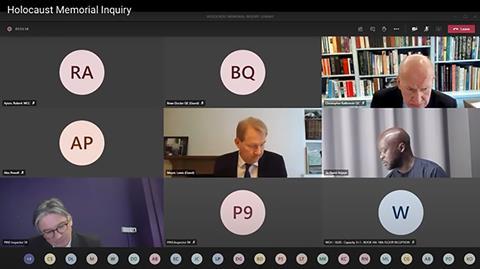Architect tells inquiry proposals will ‘shift landscape’ of Victoria Tower Gardens but not at expense of current uses

David Adjaye has told the public inquiry into his controversial Holocaust Memorial proposals, earmarked for a site in the shadow of the Palace of Westminster, that the scheme deliberately creates a busy “crescendo of the moment” effect.
The architect was giving evidence for a second day at the inquiry into the proposals created by his practice, Ron Arad Architects and landscape specialists Gustafson Porter & Bowman who won a design competition in 2017, beating a stellar shortlist.
Barrister Meyric Lewis, representing scheme opponents the London Parks & Gardens Trust and Save Victoria Tower Gardens, suggested to Adjaye that there would be “a lot going on” for people looking towards the grade I-listed Palace of Westminster from the south if the memorial were built.
“One’s got the landscaping treatment, one’s got the fins, one’s got the glimpses of Victoria Tower over behind,” Lewis said. “One’s got the Buxton Memorial behind the retaining wall with the fence on top. There’s quite a lot visually to take in going on, isn’t there?”
Adjaye replied: “What you’re looking at is a crescendo of the moment, where you see a monument, you understand parliament behind it and you see some of the elements of the park next to you, so it’s kind of a moment where we’re using this focal point to make the point about what the memorial is saying about the world in which you see, and how you see it. So it’s not just a picturesque idea, it is also an intellectual idea about context and memorials.”

Lewis noted that architecture critic Rowan Moore had described the proposals as a “cacophony”.
Planning inspector David Morgan asked Adjaye if it was fair to say he was transforming the setting of the park into the landscape for the memorial.
“The landscape is being drawn in,” Adjaye replied. “But the intention is not to change the uses of the park as a place of respite and enjoyment. We believe that’s essential for our narrative to work.
“We’re working with shifting the landscape to make the memorial, but it’s not at the expense of the use.”
Earlier in the day Adjaye was asked about the memorial’s impact on the grade II*-listed Buxton Memorial Fountain, which commemorates the Slavery Abolition Act of 1833 and is located in the gardens.
Adjaye said he believed the memorial would be “enhanced” by the proposals, but accepted that its presence would be obscured in some views.
“I think they come into a union, which is what this is really about,” he said of the planned interaction between the Buxton Memorial Fountain and the Holocaust Memorial.
Adjaye said the proposals created a new path in the gardens and that the Buxton Memorial revealed itself in a different way.
“The design decision was to leave it in place and create a relationship with the monument. That’s very clear,” he said. “There were discussions about relocating it and we rejected that.”
Adjaye also argued that raising the landscape to create a kind of amphitheatre next to Parliament would enhance events held in the park and give more visitors a view of the Thames over the river wall.
>> Also read: Adjaye ‘stunned’ by criticism of Holocaust Memorial
He was also questioned about the size of the scheme, with some objectors criticising it for dominating the park while others argue the learning centre element is too small to do justice to its subject.
Christopher Katkowsi, barrister for the Secretary of State which is promoting the scheme, quoted Adjaye’s words back to him: “Scale doesn’t equate to success.”
The architect agreed saying it was a monument’s context that was key. For instance the smaller Cenotaph gained its gravitas from its position on Whitehall and proximity to Downing Street, he said.
The inquiry is set to last five weeks.
















3 Readers' comments